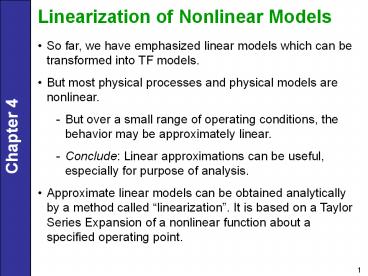Linearization of Nonlinear Models - PowerPoint PPT Presentation
1 / 16
Title:
Linearization of Nonlinear Models
Description:
Linearization of Nonlinear Models So far, we have emphasized linear models which can be transformed into TF models. But most physical processes and physical models ... – PowerPoint PPT presentation
Number of Views:195
Avg rating:3.0/5.0
Title: Linearization of Nonlinear Models
1
Linearization of Nonlinear Models
- So far, we have emphasized linear models which
can be transformed into TF models. - But most physical processes and physical models
are nonlinear. - But over a small range of operating conditions,
the behavior may be approximately linear. - Conclude Linear approximations can be useful,
especially for purpose of analysis. - Approximate linear models can be obtained
analytically by a method called linearization.
It is based on a Taylor Series Expansion of a
nonlinear function about a specified operating
point.
2
- Consider a nonlinear, dynamic model relating two
process variables, u and y
Perform a Taylor Series Expansion about
and and truncate after the first order
terms,
where and . Note
that the partial derivative terms are actually
constants because they have been evaluated at the
nominal operating point, Substitute (4-61) into
(4-60) gives
3
The steady-state version of (4-60) is
Substitute above and recall that
Linearized model
4
q0 control, qi disturbance
Use L.T.
(deviations)
Chapter 4
linear ODE eq. (4-74)
More realistically, if q0 is manipulated by a
flow control valve,
nonlinear element
5
Example Liquid Storage System
Mass balance Valve relation A area, Cv
constant
6
Combine (1) and (2),
Linearize term,
Or
where
7
Substitute linearized expression (5) into (3)
The steady-state version of (3) is
Subtract (7) from (6) and let ,
noting that gives the linearized
model
8
- Summary
- In order to linearize a nonlinear, dynamic
model - Perform a Taylor Series Expansion of each
nonlinear term and truncate after the first-order
terms. - Subtract the steady-state version of the
equation. - Introduce deviation variables.
9
Chapter 4
10
Solve Example 4.5, 4.6, 4.7andSolve Example
4.8if you have any questionask me !
11
State-Space Models
- Dynamic models derived from physical principles
typically - consist of one or more ordinary differential
equations (ODEs). - In this section, we consider a general class of
ODE models referred to as state-space models.
- Consider standard form for a linear state-space
model,
12
- where
- x the state vector
- u the control vector of manipulated
variables (also called control variables) - d the disturbance vector
- y the output vector of measured variables.
(We use boldface symbols to denote vector and
matrices, and plain text to represent scalars.) - The elements of x are referred to as state
variables. WHY? - The elements of y are typically a subset of x,
namely, the state variables that are measured. In
general, x, u, d, and y are functions of time. - The time derivative of x is denoted by
- Matrices A, B, C, and E are constant matrices.
13
- Example 4.9
- Show that the linearized CSTR model of Example
4.8 can - be written in the state-space form of Eqs. 4-90
and 4-91. - Derive state-space models for two cases
- Both cA and T are measured.
- Only T is measured.
Solution The linearized CSTR model in Eqs. 4-84
and 4-85 can be written in vector-matrix form
14
Let and , and denote their
time derivatives by and . Suppose that
the steam temperature Ts can be manipulated. For
this situation, there is a scalar control
variable, , and no modeled
disturbance. Substituting these definitions into
(4-92) gives,
which is in the form of Eq. 4-90 with x col
x1, x2. (The symbol col denotes a column
vector.)
15
- If both T and cA are measured, then y x, and C
I in Eq. 4-91, where I denotes the
2x2 identity matrix. A and B are defined in
(4-93).
- When only T is measured, output vector y is a
scalar, and C is a row vector, C
0,1.
Note that the state-space model for Example 4.9
has d 0 because disturbance variables were not
included in (4-92). By contrast, suppose that
the feed composition and feed temperature are
considered to be disturbance variables in the
original nonlinear CSTR model in Eqs. 2-60 and
2-64.
Then the linearized model would include two
additional deviation variables, and
16
Stability of State-Space Models
- The model will exhibit a bounded response x(t)
for all bounded u(t) and d(t) if and only if the
eigenvalues of A have negative real roots - Solve example 4.10
Relationship between SS and TF
- Gp (s) C sI-A-1 B
- Gd (s) C sI-A-1 E
- Solve example 4.11































